Bigger Screens Attract More Viewers, Longer Viewing

Just for laughs, sometimes I bring out my old, old flip phone.
You know, “Beam me up Scotty.”
Our son splits a gut, our daughter is kinder. But what do they know…it’s going to try and make a comeback.
Still, son can’t believe all we did with it was make/receive phone calls.
He also gets a kick out of our old iPhone 2 and wonders how he could possibly play Shadowgun Legends or watch HBO’s Game of Thorns on such a little screen.
Our daughter just rolls her eyes and goes back to her new iPhone big screen texting, IGTV (Instagram TV) videos and the latest whatever Netflix show she’s into this week.
That’s why we were a little surprised when the new old Palm was rolled out. It’s even smaller than the first iPhone Jobs showed to the faithful back in ’07.
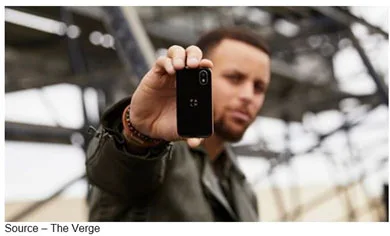
Golden State Warriors’ Steph Curry is an investor in the new company, is its creative strategy director, and has a terrific fan base; but seriously?
A little bigger than a credit card, you can read texts, respond, take some so-so pictures and probably watch a YouTube video if it is extremely short.
In other words, it’s the backup phone to carry if you’re trying to wean yourself of constantly being online with yourself.
About the only person we can think of who would take delight in it was a reviewer we read years ago who panned the introduction of a unit that bridged the gap between a phone and tablet.
The reviewer rhetorically asked at the time why anyone would want a phablet (mash-up word)?
According to Strategy Analytics, just about everyone!
Now folks are waiting anxiously (at least device manufacturers hope) for their foldable screen phones but jeezz $2K?
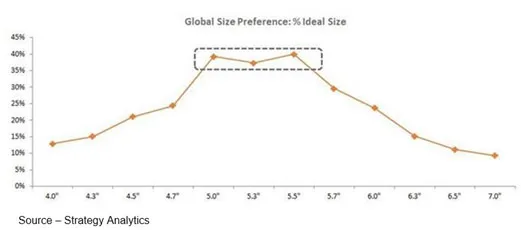
A major reason for the demand/need for a larger screen is there are more people going online with their smartphones than with their desktop/laptop computers.
According to the recent Ericsson Mobility report, there will be 28B connected devices in the world by 2022–including 16B IoT devices, 9B phones, about 1B desktop/laptop computers.
At least 8B of these devices will have audio/video connections.
In other words, there are connected devices and then there are connected devices.
People who go online exclusively via desktop or laptop computers are becoming scarce in the US and most industrialized countries.

Smartphones added about half a billion new devices to the market since a year ago and they now outnumber tablets by 6 to 1.
According to eMarketer, over three-quarters of US internet users will access the internet via both a mobile device and PC; and there were roughly 9 million new dual-device users during the last year.
IHS Technology notes there are an average of four connected devices per household globally and in North America, closer to 13 devices.
Devices with AV capabilities globally are:
3.4 Billion—Smartphones
1.8 Billion – PCs
1.4 Billion – Audio hardware
.73 Billion – Tablets
.51 Billion – TV-attached devices
.29 Billion – TVs
Last year, Gary Shapiro, CTA president and CEO, noted, “Connectivity — the anytime/anywhere access to information and entertainment we now expect — is a driving trend of our time, supported by the continued growth we’ve seen in smartphone ownership. Smartphones are our personal hubs for innovative technologies like smart homes, connected cars and voice-recognition services. And, as more of us recognize the ability of technology to change our lives for the better, smartphones will continue to be one of the most pervasive technologies owned in homes throughout the U.S.”
CTA likes to remind us that TVs are still the most popular device in US homes with more than 96 percent of households owning at least one.
Still, smartphones are the most pervasive device in the world!
The reason why more digital minutes in the US are consumed on mobile devices than desktops (despite a greater desktop audience) is heavier usage on mobile.
As smartphones and data plans become more affordable and the wireless infrastructure becomes faster and more reliable; mobile-only users will steadily increase in the years ahead.
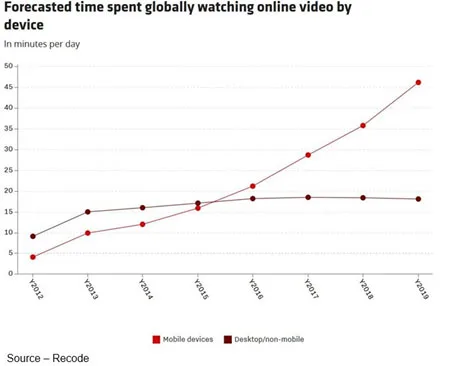
In fact, mobile users in the US consume about 2.5 times more minutes per month than desktop users.
According to comScore, mobile devices combined for 70.3 percent of all digital minutes in the US in December, up from 66 percent in January 2016.
Two-thirds of video views in the US were on mobile devices, about the same as in the UK (69 percent).
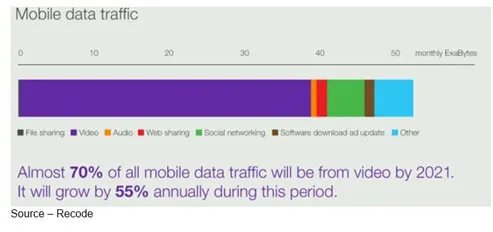
And it’s growing!
Which means that in addition to our kids’ phones, Netflix, Amazon Prime; YouTube and yes, even your local grocery store, address 339 million connected devices in the US or about 32 percent of the AV hardware landscape.
To support the video consumption changes, SMPTE (Society of Motion Picture and Television Engineers) have made tremendous strides in streamlining content distribution with more efficient, more bandwidth-conservative codecs (compresses data to enable faster transmission and decompresses received data) and other standards to enhance the viewing of 4K and HDR content.
Of course, the crucial part is outside of their control, the improvements of network connectivity that can change the way we enjoy content.
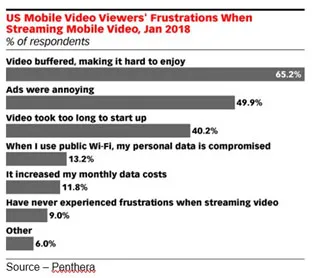
Despite the development of advanced mobile technology, the average network still struggles to meet everyone’s on-the-go viewing needs.
4G LTE meets the HD and even 4K streaming needs of folks who live in densely populated urban areas; and 5G, which will begin broader distribution early this next year, will be a giant leap forward if you live in the right part of the country/city.
And carriers – AT&T, Verizon, China Mobil, Vodaphone, America Movil, T-Mobil, Sprint and others – are doing a great job of spinning the dream that shortly you’ll be enjoy the breathtaking of 5G of always-on connection to instantly and effortlessly enjoy great content.
For example, the UK’s BT managing director proudly stated recently, “For millions of consumers across large parts of the UK, that is already a reality. With latency sub-50ms and average speeds of 30Mbps – with peak speeds as high as 400Mbps – many consumers have a great mobile video experience already.”
He added that with his smartphone, he can download at well over 100Mb/sec with no buffering.
He’s quick to qualify that noting that it isn’t always the same for many mobile users in the UK; but they, and other carriers around the globe, are expanding their coverage to get rid of ‘notspots’ and give folks better reception.
Not certain about you, but we believe the phone guy even less than we believe the cable guy so we’re betting it’s going to be a while for most folks.
And if you happen to live in a rural area, you’d probably be happy just to get reliable 4G or even 3G coverage.
5G though will be a game-changer when it comes to fulfilling the vision of high-speed data access and Wi-Fi speeds when you leave home.
Expanding on the core 4G LTE network, which is like today’s fixed broadband network, they will deliver core capabilities closer to the individual user.
Latency (network responsiveness) will be important to mobile viewers and will be critical for applications like healthcare and autonomous transportation.
 It’s going to be important when my wife is watching Steph and the Warriors on her device.
It’s going to be important when my wife is watching Steph and the Warriors on her device.
When that’s possible, then screen size and battery life will become even more important for her and we might be able to convince her it’s time to upgrade.

Until then, she’ll probably stick with her present phone for texting and following the stats/online commentary while watching the game on our huge screen TV.
Logical folks like her are actually the PC/CE industry’s major target because they want us to upgrade our devices.
You know, as soon as the newer, faster, better whatever is introduced, increase your enjoyment.
Phil Schiller, Apple’s senior VP of worldwide marketing, emphasized at their September phone/wearable unveil (not to be confused with the October computer event) that it was “really sad” that more than 600 million computers in use today are more than five years old.
On the upside for Phil, folks have squeezed about all the work/play flow out of their computers they have and yes, CTA and IDC see an uptick in computer sales (finally) this year.
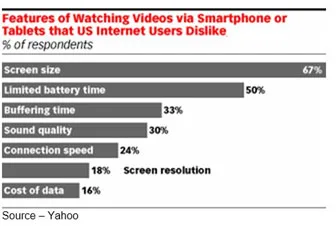
As for smartphones?
- Great cameras? Check
- Great screens? Check
- Great performance? Check
- Great battery life? Check
- Great content available? Check
- Great content delivery performance? So/so
- Great service pricing? Are you kidding!
 Content creators are ready, device manufacturers are ready, consumers are ready; but it’s sorta’ like Cory Lambert said, “You don’t catch wolves looking where they might be, you look where they’ve been.”
Content creators are ready, device manufacturers are ready, consumers are ready; but it’s sorta’ like Cory Lambert said, “You don’t catch wolves looking where they might be, you look where they’ve been.”
A smaller phone probably won’t do it.
Everyone is waiting on the phone guy to deliver fast, reliable and economic service … emphasis on reliable, economic.
# # #